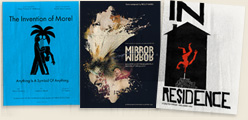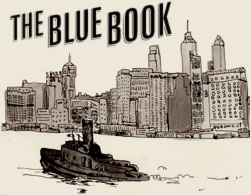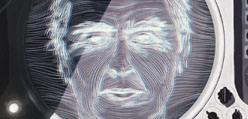The Audions
Dimly Glowing
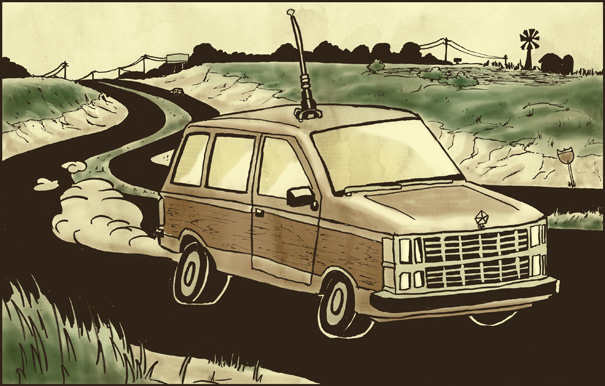
Illustrations by Dmitri Jackson
Black box daddy
Paps drove the family west in the spring of 1991. When we reached the prairies at the Minnesota–Dakota border I could feel the distance ahead, all 2,500 miles to Los Angeles.
I could’ve died and gone to heaven. Our Chrysler was a van from the middle part of the prior decade, with wood panels on both sides and a tan paint job that had lost its factory finish. Wall Drug was still a couple hundred miles ahead. There wasn’t even a gas station between. The world felt awfully empty that day, awfully big. There were fields of low wheat in all directions.
My family was with me. Jimmy and I sat in the very back, Sarah and Emily in the middle, Mom and Paps up front. Strange voices came out of a speaker fastened to the dash. Paps said it was ham radio. He operated it by way of a special antenna attached to the roof by a giant magnet. I wondered why they would name a radio after a ham.
The sun was out. I stared out the window, but couldn’t stand the emptiness. I asked if we could turn on some music.
“Not now,” Paps said. “I’m listening.”
e-Candy
This is a heyday for interfacers. I am talking about people who prefer tech media exchange to the slog of face-to-face.
With so many online networking options available, interfacers are kids in a virtual candy store. What’s more, services are zero cost. Free candy? Who wouldn’t sign up? Sweet teeth aside, at least two free networks are currently emergent as real (cultural and economical) relevants: Facebook and Twitter.
Facebook has outgrown the humble britches it wore in its early days on the college network circuit. It provides a hybrid service to its users: a circus of applications, a competent messaging service, status feeds, and image-sharing abilities, to name a few, never mind the wonders of profile creation. Goodbye frumpy you—hello photogenic avatar! Users create exceptional online identities with the tools Facebook provides, keep in close touch with family friends, and entertain themselves while doing it. The service (for now) does not cost a single Yankee dime. That’s some kind of deal.
We haven’t yet fully realized Twitter’s utility. Its undefined potential fuels its vaguely defined hype. What do you do with it? Well, sort of whatever you want, or can. As a user, you author its purpose. It poses a sincere competitive threat to Facebook in that it might become something really big. But until it is clear how that will happen, leave the “mights” on the back burner. Twitter has something subtler going on by way of interface appeal: Facebook is full of bells and whistles, but Twitter is fun, new, and easy as pie. The single-function, minimalist appeal of Twitter is precious, and has Facebook looking cluttered and busy, old-fashioned. The neatly beveled feed photos only add to Facebook’s old-timey effect. For now, Twitter is the up-and-coming contender, the young gun on the ranch. Facebook—and its gobs of proven revenue—is the stud.
CNET forecasts a sort of Space Race to Riches between the two. Facebook is the hare out ahead, but the Motley Fool confidently chats about why Twitter could be a billion-dollar tortoise. Facebook’s since-revoked revision of its privacy terms was pretty sinister. But what might have become more damaging has fizzled out into a slight public relations disaster, giving management a better idea of where the buck stops with interfacers. Twitter is newly flush with cash in 2009. Facebook has plenty already. What is an interfacer to make of it all?
First, you had better figure out where you figure in. There is an obvious smoke-and-mirrors side to all of this, which is that Facebook and Twitter provide service free of charge. Corporate generosity is never anything more than friendly marketing. It’s all about the Washingtons. So where do the amazing amounts of revenue Twitter and Facebook generate come from? Advertising potential achieved, of course. Interfacers are gaga for online social networks, and advertisers exploit that demand. Advertisers employ more effective strategies, real-time advertising, or trend-spotting programs, and increase revenue. Why else would online social networks be about as easy to join as putting on a shirt in the morning?
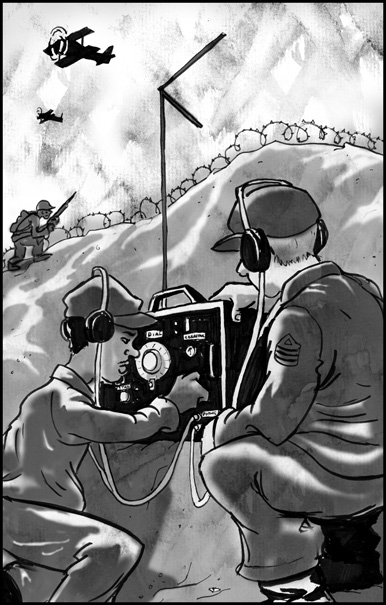
Its time in the sun
Online social networks are the chicken after the egg. For a plain take on ancestry, look no further than the holy trinity of electronic media outlets: the Internet, TV, and the old standby, radio.
In three generations’ time, a family tree of technology rapidly transformed our lives by reinventing the way we consume information and then selling it to us at profit. Each had its own method. Online social networks—with their pastiche models of associating images, texts, and sounds—are the Internet’s most effective marketing accomplishment to date.
Tip your hat to that static-happy radio first. It set the grade. The others had an example to follow that made it easier. Online programmers have only had to reinvent the communications wheel. To get your head around the impact of radio, it’s best to start at a middle frequency in its oddball history, then to move forward and back along the bandwidth. MIT Press published a book by Kristen Haring called Ham Radio’s Technical Culture. It’s a super chronicle of amateur radio’s community development. Haring’s heroic World War II “radio war” operators used radio to contact far-off soldiers, to spy on enemies, and to broadcast propaganda. They were essential to the war effort. By the scholar Richard Bartlett’s account, it didn’t take long after the war’s end for marketers to gather “the concept of radio broadcasting as a communications device...recognized as a source of entertainment, information, news, propaganda, profit, and as a channel for marketing everything from religious sects to soap.” The troops came home. They’d been trained on the gear, and they found jobs waiting for them in the commercial radio industry. What had been an amateur’s hobby before the war fast became a business. The boom was on. The American purchasing public was falling for technology. Amateur radio operators turned professional. Money was coming in fast. It was impossible to tell which made men of boys faster: war or steady business.
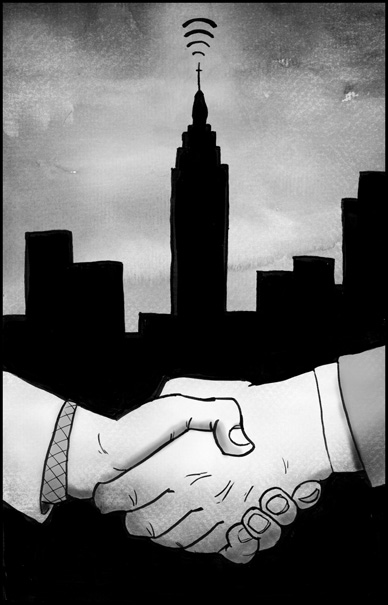
The early days of old man radio
President Calvin Coolidge presided over the International Radiotelegraph Conference in Washington, D.C. in the fall of 1927. Most attending nations—a common roster of European powers—had a bone to pick with the amateur radio operators who had terrifically inverted conventional communication techniques.
A nationalistic preservation instinct warned of the imminent loss of state-run communications monopolies; nations preferred to keep a tight lid on information exchange. At the time, the United States, with more than 16,000 licensed amateur radio operators, had more operators than the rest of the gathered nations put together. Despite the desire of some to silence the amateur airwaves, the swelling ranks possessed too strong a voice, and a treaty was reached.
Pre-news-radio newspaper reporters swarmed the granite steps at the conclusion of the Conference. They jostled around Kenneth Bryant Warner to hear the Secretary-General Manager of the American Radio Relay League (ARRL) proclaim that “The unyielding world [had] yielded.” This headline-making announcement underscored the importance of an international agreement that optimistically embraced the Age of Information and demoted mechanical production to a second-tier support role. Information became the new paramount product. There is great freedom in broadcast. It’s another kind of speech. American broadcasters were now free to broadcast to the darkest corners of the globe. Was it a bad idea for one of them to do a spot for Wrigley’s chewing gum now and again?
Black box remembers
Q: Hi Paps,
I’m writing an article. Can you draw a line between your ham hobby, your career in engineering, and your interest in computers/online communities?
I’d much appreciate it. I’m not looking for anything specific, so whatever comes to mind.
Thanks!
A: My career in engineering comes originally from my interest when young about how things work and interest in taking things apart, including cameras, radios, TVs, toys, etc. I was “attracted” to the electrical parts mostly but the mechanical parts were neat too.
This led to an interest in taking an electronics class in high school and collecting electronic parts from old gear that I did take apart—capacitors, resistors, knobs, tuners, all kinds of things. Grandpa Laurence Mapel once told me that he flipped a coin to decide whether he would study electrical or chemical engineering (the coin landed on chemical—this is what he studied at Ohio State and he worked for O’Brien paint company as their chief chemist for 30 years). This helped me decide to pursue electrical engineering after reading up more on it and what it was all about. I decided Purdue was a good, affordable school with a great reputation in engineering (much less costly than Notre Dame at the time).
After getting my first job at Rockwell / Collins, I was asked to help one of the project engineers responsible for the mini-computer that ran in an Air Force satellite communication system, to help him with the software. My boss looked around the room in a group meeting and looked for a volunteer—I raised my hand rather sheepishly. I never looked back. I had “turned to the dark side” (software). I had always been interested in computers and so I got a chance to get into software as I describe it, by “accident”. So it is interesting how one’s life can take a turn towards something unexpected.
My ham radio interest stems from my Rockwell friends as the company was big into communications and had all kinds of radio products, TV transmission equipment, exotic military communications gear that was all very neat. They had an antenna “farm” in a field next to one of the buildings that was amazing—the ability to communicate around the world. The company had a lot of hams in town that belonged to several clubs. So it was not difficult to get hooked into building an amateur radio from plans that one of the guys had designed. One could buy all the parts through the employee store—and then I could take the radio into our lab and use all the great, expensive test equipment to tune the radio and get it all working well.
We had no email in the ‘70s while I was at Rockwell. But after we went to MN and I worked at Honeywell, I encountered email and, although I had an account along with fellow co-workers, not many others had email capability, so I didn’t get all that many messages in a week’s time. As a matter of fact, I had the computer (a big mainframe) set up to print my email early every morning and then I would stop by the printer room and pick up any printed messages waiting for me in my slot. I could go on about the early days of computers and how microprocessors came on, but I’ll leave that story to another day. Before the Internet, there were BBS systems that one would call—Bulletin Board Systems. You would call special phone numbers and dial into them—most were privately run and owned. It was hit and miss as to what you would find on them but many were devoted to specialized topics such as news, sports, various clubs, and of course pictures of women of all kinds. There were hundreds if not thousands of BBS’s all over the country and many required one to join and potentially call into them on long-distance numbers (unless they offered 800 numbers). Then there was a system called Gopher (from U of MN). Gopher offered a centralized place to store all kinds of information—this was eventually supplanted by the actual Internet which of course grew rapidly out of a government system. Check out Wikipedia for the history of the Internet and I am sure you will get all kinds of good info there.
So now with cell phones, cable TV, hi-def, Wifi, great computers, and all kinds of electronic gadgets, we have all the cool stuff we have today—all fueled mainly by fast, cheap microprocessors, lots of memory and very cheap storage. Who knows where it will all end if ever?
How’s this for something for you to chew on?
Paps
Old man radio in print
“Efforts to create a system by which amateurs could convey messages to people across the country had challenged thousands of radio hobbyists. Their aim was to achieve successful relays.... The relaying of messages was a mastic that brought hams from all over the nation together with a common purpose. The challenge was constant.”
— American Radio Relay League (ARRL) founder Hiram Percy Maxim
“When you no longer have to string out your stations in a chain, but any one of them is able to work all the others, what have you? You have a ‘net’ and that is what the ARRL traffic handling system became—what the government services call a ‘free net.’”
— QST Magazine
“The need of a special means of international communication between radiomen for business and progress is upon you. It has come like a flash from a blue sky. What are you going to do about it?”
— Oscar C. Roos, creator of IL (International Auxiliary Language)
“There is a genuine fascination for us on any old night when we marvel of our ability to sit in a half-darkened room before a little collection of instruments, with the audions dimly glowing and hear the messages from our friends come buzzing in through the night.”
— K.B. Warner of the ARRL
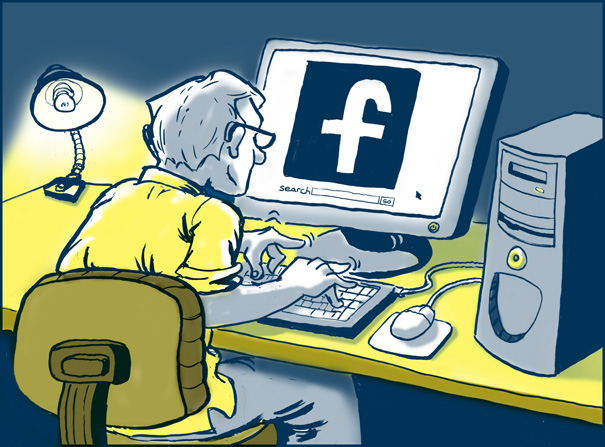
e-Candy cavities
Kristen Haring, the MIT Press author cited above, thinks “technical culture emerges from the two interrelated processes of technical identification, creating meanings for technology and perceiving self in relationship to technology.”
Online programmers are only now applying to their own technology what ham radio operators long ago accomplished in theirs. Haring writes about how “technical hobbies offered opportunities for working through altered visions of self and surroundings brought to light by technological change.” That is amateur radio’s greatest value as example and current guide: it changed the way people communicated. It created a whole new vocabulary and updated human potential for information exchange. With magnificence, it fundamentally altered the way people related to one another. In time, its currency manifested itself into actual economy. The experiment and its success are invaluable, and go well beyond profit margins.Today’s online communities and social networks follow a similar code. Innovators master computer programming, and develop skills to construct and realize their ideas. The greatest challenge of all, the ultimate make-or-break, comes with the ability to sell it. Technology as a product for public consumption today is hyper-stylized, its user interface almost as important as its technical façade. The concept has been formulated into a hybrid tech-business model, with a set of economic how-to’s all its own.
It’s easier to follow a code than it is to write it. What is the value in the tools our times produce beyond their ability to more effectively sell us things? Facebook and Twitter give people the chance to stay close despite distance, increasingly hectic schedules, and a pervasive cultural shift away from conventional community models. If there is one essential service either of them provide, it is that. I treasure that quality in these tools, but only because it is free. Under no circumstances whatever should our relationships become commodities unto themselves. We’ve been through all that offline, and these online social networks are an opportunity to resurrect that social failure.
A black box product is user friendly, but doesn’t tell you what’s going on inside. Paps is a lot like that, sort of reserved. His hobby puzzled me as a kid. I used to wonder who he met on the overnight airwaves while his family slept, prowling down the moonlit highways of New Mexico and west Texas on our return from the Pacific Coast. I don’t wonder what they talked about anymore, out of respect for his privacy. He spent his life building the insides of the black box, authoring software to make things easier for me. He has accomplished more than I could yet dare. He had the right to live off the record. Being very active online, I may never have that privilege. I’d be a fool to spend my time trying to hack him back open. What do I know? Some things are better left undone.
At its technological, social, and cultural summit, amateur radio bloomed into radio war and industrial gain. Examine its origin. At the seed there was no malice. The stem of an inventive technology grew tall to the blossom. If you look back then, you can see how the flower jostled in slow wind, in mixed tolerance of its environment and with roots in pragmatic soil. It was a plant in the spring bloom, its spores loosening up. There began the broadcast.




